|
Crop nutrition:
Management of micronutrients
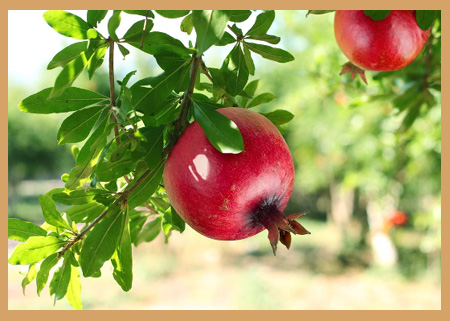 Research
findings have indicated that optimum quantity of
fertilizers and time of application for efficient
utilization of nutrients can reduce decline in
pomegranate due to diseases. Response of micronutrients
like Zn, B and Mn has been noted for increasing the
quality and yield of fruits. Research
findings have indicated that optimum quantity of
fertilizers and time of application for efficient
utilization of nutrients can reduce decline in
pomegranate due to diseases. Response of micronutrients
like Zn, B and Mn has been noted for increasing the
quality and yield of fruits.
Nutrient status
Nitrogen:
Nitrogen is one of the primary nutrients absorbed by
pomegranate roots, preferably in the
form of nitrate
(NO3 - ). The pomegranate
fruit crop
requirement for N is equal to the amount of N contained
in the harvested fruit as residues are generally
recycled in the pomegranate groves. Mature fruit contain
approximately 0.25 kg
N per 100 kg of fruits. If the residues are not
removed from the pomegranate groves then replacement of
this N can meet the requirement of pomegranate fruits.
Blooms, fruit, woody tissues (both above and below
ground), and leaves all contain N and other nutrients.
As these materials fall to the ground, some
(approximately 50%) of the N they contain is recycled
within the grove. Therefore, pomegranate trees must take
up N in excess of the crop requirement for young trees
to increase in size.
Optimum leaf nitrogen concentrations
for pomegranate ranges from 1.5 to 2.0%.
If leaf N falls below this range then application
of nitrogen is recommended.
A note of
caution- since pomegranate crop is susceptible to wilts
and blights, care should be taken to see that while
recycling the residues, the disease inoculum should
not build-up in the groves.
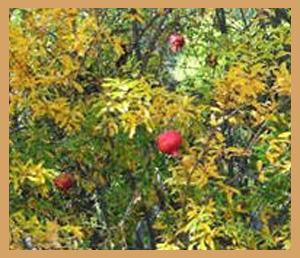 |
|
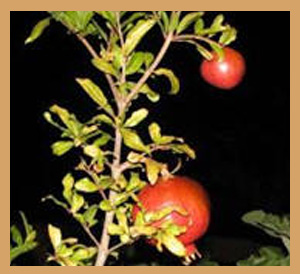 |
| Pomegranate tree showing general yellowing of
leaves starting from older leaves with some
leaves in “Yellow vein state |
|
A close up view of a branch showing chlorosis of
older leaves, younger leaves remaining green. |
In nitrogen deficient pomegranate trees,
there is no distinctive leaf patterns.
Generally deficiency is expressed by light green
to yellow foliage over the entire tree. As the
deficiency intensifies foliage will change the colour
from light green to yellow. New flushes usually emerge
pale green in colour, but darken as foliage expands and
hardens. During severe deficiency the leaf exhibit a
symptom called “yellow vein chlorosis”.
In Karnataka, the
midribs and some lateral veins also turn yellow, while
the rest of the leaf remains with normal green colour.
It may also occur with the onset of cooler weather in
winter, due to reduced nitrogen uptake by the plant from
the soil. Nitrogen deficiency is also associated with
senescing older foliage, which can develop a
yellow-bronze appearance prior to leaf abscission.
Nitrogen deficiency will limit tree growth and fruit
production, while high nitrogen applications produce
excessive vegetative growth at the expense of fruit
production, reducing fruit quality.
Phosphorus:
Phosphorus is a very important nutrient required for
obtaining satisfactory yield and quality of pomegranate.
But the quantity required is not as high as other
fruit crops like apple, mango etc. as very little P
is removed by fruits.
P does not leach readily where the soil pH is 6
or higher and most of the pomegranate soils fall under
this category. As
a consequence of this over the years, P applied to
established groves
had accumulated in the soil at high level and is
available slowly to the plants. Therefore, regular P
applications are not necessary and fertilizer
application should be done on the basis of soil test.
Excess P in pomegranate can cause imbalance in other
nutrient availability and affect fruit quality, cause
irregular maturity, and increased expression of aril
browning and wind scars on the fruits.
Some soils used for new plantings are naturally low in P
particularly in highly calcareous soils of Telangana and
Vidharba regions. In this situation, P fertilizer should
be applied until a soil test P rating of medium to high
is achieved. Phosphorus fertilizer should be applied
each year in newly planted groves on previously
non-fertilized soil until the groves begin to bear
fruit. As the trees approach economic bearing stage, P
applications may be reduced or omitted. Diagnostic
information from leaf and soil testing must be
considered to determine if P fertilization is necessary.
Optimum leaf phosphorus concentration for pomegranate
ranges from 0.1 to 0.2%.
If leaf P falls below this range then application
of phosphorus is recommended.
Phosphorus deficiency is not common in pomegranate
groves except under soil adverse conditions like on
highly acid and calcareous soils. If it does occur, it
is more difficult to diagnose than nitrogen (N)
deficiency or other nutrient element deficiencies.
Growth is reduced when P supply is too low. Phosphorus
is highly mobile in plants, so when it is deficient, it
may move from old leaves to young leaves and other
actively growing areas where energy is needed to form
seeds and fruits. Deficiency symptoms appear first on
older leaves, with a lustreless bronze discolouration.
Some leaves later develop necrotic areas, and young
leaves show reduced growth rate. Leaves shed
prematurely, and fruit can drop before normal harvesting
time. Trees exhibit limited flower development with
reduced fruit set and fruit yield. The fruit turns rough
in texture with poor aril development. The fruit
maturity is delayed because of high acidity in
proportion to total soluble solids. Usually, roots are
stunted and poorly branched.
 |
 |
|
a lusterless bronze discolouration of both
younger and older leaves and reduced size of
younger leaves, |
trees
with limited flower development and
reduced fruit set and fruit yield. The
fruit turns rough in texture with poor aril
development
|
Potassium
Potassium deficiency in pomegranate groves is common as
the crop demand for K is high.
Normal vegetative growth of pomegranate can occur
under a wide range of K content in the leaves. On the
other hand, the leaves should contain a certain level of
potassium, if the tree is to provide fruit with high
yield and quality. The potassium content of mature
pomegranate trees sometimes exceeds
that of nitrogen (N), as K is the most abundant
mineral in the fruit. The juice is a strong sink for K,
which occurs there mainly in the form of soluble K salts
of the organic acids. Therefore, it is essential to
apply potassium fertilizers to replace the K removed by
the fruit,
to improve fruit quality; and
to maintain soil productivity. Potassium does not
usually affect tree growth over a wide range of
variation, unless it falls below 0.3% in index leaves.
Since yield is positively correlated with tree size
(volume) it is essential to have adequate content of K
in the tree. The K content in the leaves decreases
during the fruiting season and fruit load can enhance
this decrease as a result of K mobility towards fruits.
Appropriate fertigation can prevent the decrease in K or
reduce the negative effect of yield on K content.
Optimum
leaf potassium concentrations for pomegranate ranges
from 0.6 to 0.8%.
If leaf K falls below this range then application of
potassium is recommended.
Unlike other fruit crops, potassium deficiency is not
conspicuous in pomegranate.
Generally it results in poor fruit retention,
reduced fruit size, with scorched leaves.
But under
extreme cases of potassium deficiency the leaves dry up
leading to shedding of all fruits and death of
the twigs.
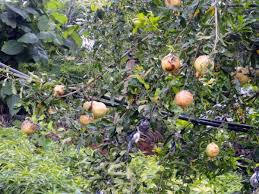 |
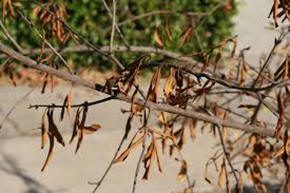 |
|
poor fruit retention reduced fruit size, with
scorched leaves |
trees in extreme cases of potassium deficiency
with leaves drying leading to shedding of all
fruits and death of the twigs. |
Calcium:
Calcium deficiency in pomegranate is rare but occurs on
acid and highly leached soils
like
in red soils of Deccan plateau.
Symptoms resemble those of boron deficiency.
Leaf lamina shows chlorotic mottles and under
severe deficiency these extend from margins spreading
downwards and inwards.
Fruits develop blossom end hardening and also
fruits develop cracks(Plate 4A,B).
Excess potassium and magnesium application
aggravates calcium deficiency in pomegranate.
Optimum leaf
calcium concentrations for pomegranate ranges from 0.7
to 1.5%. If
leaf Ca falls below this range then application of
calcium is recommended.
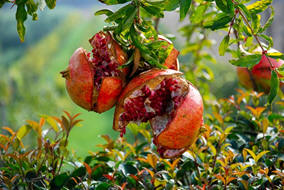 |
|
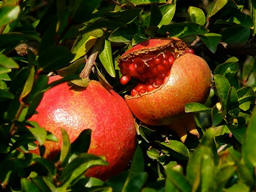 |
|
pale yellow older leaves with lateral fruit
cracking, |
|
leaves curving inwards with lateral fruit
cracking. |
| |
|
|
|